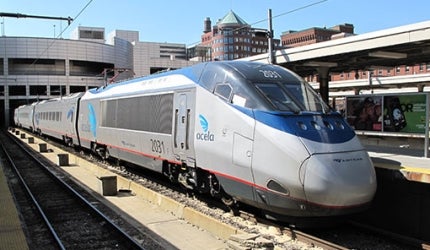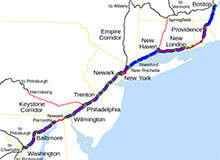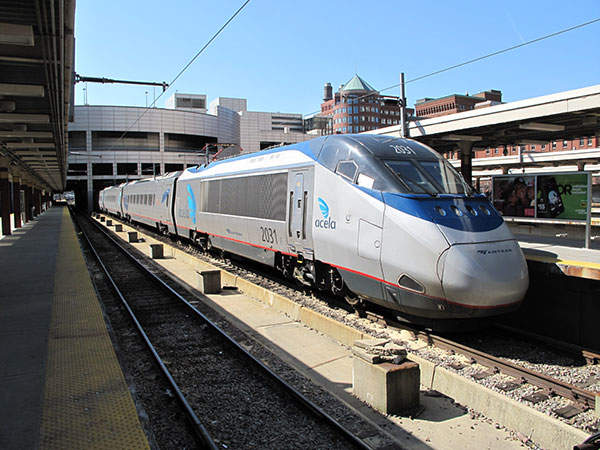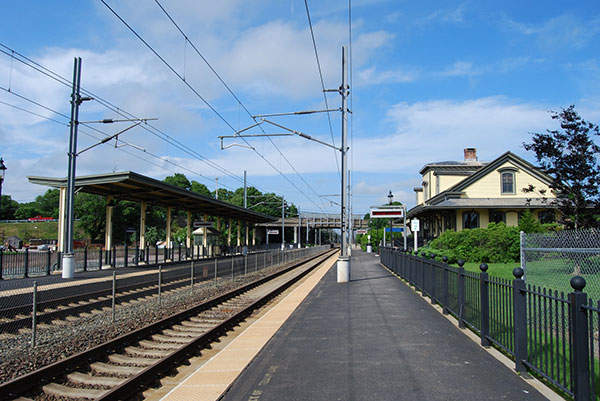
The Northeast Corridor (NEC) is a 457-mile (735.5 km) rail line connecting highly urbanized areas in the United States. It is the busiest railroad in North America, stretching from north to south and passing through eight states. It starts in Boston, Massachusetts and ends in Washington, DC, via New York and connects many cities in between with the District of Columbia.
Operated by Amtrak, the fully electrified rail line carried 17.1 million passengers in 2015. The Acela Express, a Northeast Regional service that operates between New York and Washington, D.C., operates at the NEC. The corridor is also used by a few other Amtrak routes, as well as various rail and freight services.
In September 2010, Amtrak revealed its plans to upgrade the NEC to a high-speed corridor operating at speeds of 220 mph (354 km/h). The upgrade is estimated to require an investment of $151 billion and is scheduled to be completed by 2040.
The White House Council began a pilot program to obtain an Environmental Impact Review for the NEC high-speed rail project in January 2012. Full-scale construction began in 2014.
History of the Northeast Corridor rail project and its upgrades
“The fully electrified rail line operated by Amtrak carried 10.89 million passengers in 2011.”
The NEC was built between 1830 and 1917, with electrification taking place between 1905 and 1938. Amtrak acquired the rights of way to the NEC in 1976 as the railroads that operated the corridor went bankrupt.
The Northeast Corridor Improvement Project (NECIP) began in 1976 to upgrade and modernize the line. It included safety improvements, modernization of signaling systems, installation of new Central Electrification and Traffic Control Centers (CETC) and introduction of AEM-7 engines.
The Northeast High Speed Rail Improvement Program (NHRIP) was implemented on the line in the 1990s. Acela Express trains were introduced to reduce travel time between cities. Grade crossings were removed, bridges rebuilt, curves modified and tracks electrified to make them compatible with Acela trains.
The Acela Express rail service on the NEC line began in December 2000. It marginally reduced travel time between cities, which allowed rail services to compete with air services.
Details of Amtrak's Northeast Corridor upgrade project
The NEC's ridership eventually grew beyond capacity with the introduction of the Acela Express train service. Accordingly, proposals were made to upgrade the NEC line. The Northeast Corridor Infrastructure Master Plan and the Northeast Corridor High Speed Rail Vision were released in 2010.
Amtrak has proposed a new high-speed corridor along the entire line, which envisions a new interior route through Connecticut. A brand new 426 mile double track high speed corridor was decided to be built, after a series of consultations and discussions. This new high-speed corridor will cut the travel time between Boston and Washington to about 3.5 hours.
The high-speed corridor will allow trains to run at 140 mph (225 km/h), while the current speed is just 120 km/h, and all intermediate stations will be bypassed through tunnels and new stations. Amtrak expects the line to generate $1 billion in annual revenue and increase annual ridership to 38 million by 2050.
Development and construction of the Northeast High Speed Corridor
The NEC High Speed Corridor is planned to be promoted under two programmes, the NEC Upgrading Program (NEC-UP) planned between 2012 and 2025 and the Next Generation High Speed Rail (NextGen HSR) Program for 2025 and 2040.
“It's the busiest railroad in North America, running north to south and passing through eight states.”
The NEC Investment Program was formulated by key NEC stakeholders as a step towards the implementation of the High Speed Up-Gradation programme.
The $14.7 billion Gateway project was proposed by Amtrak in February 2011 and includes upgrades to electrical infrastructure, signaling and track between Morrisville New Brunswick and New Jersey, which is one of the busiest sections of the NEC. Amtrak received $450 million in funding for the gateway project from the US Department of Transportation in May 2011.
The proposed project will be fully integrated into the new Northeast Corridor Infrastructure and Investment Development business line proposed in November 2011.
Contractors participating in Amtrak's Northeast Corridor
Alstom was awarded a $2 billion contract by Amtrak to deliver 28 high-speed trains for the Northeast Corridor in August 2016.
Alstom is also responsible for providing technical support, spares and parts to maintain the new trains.





